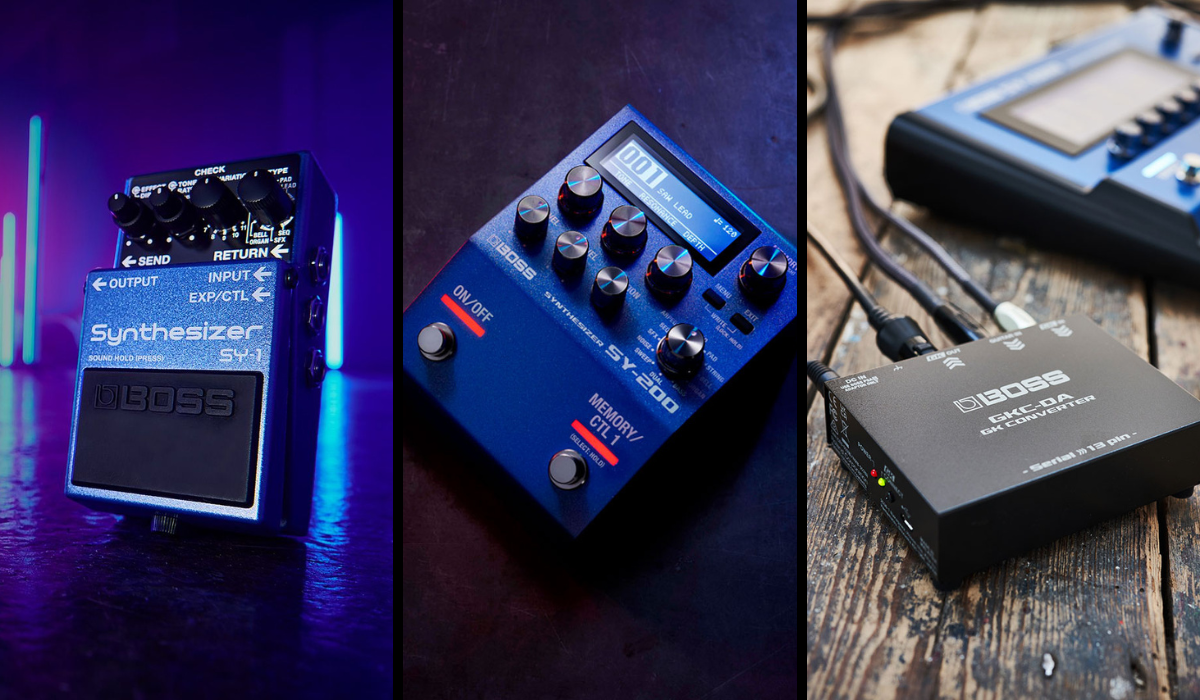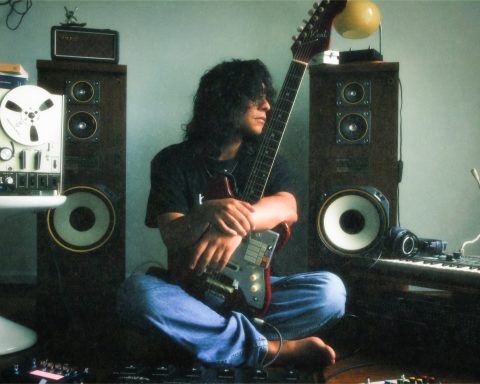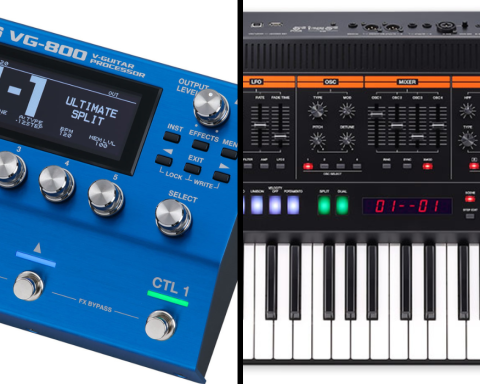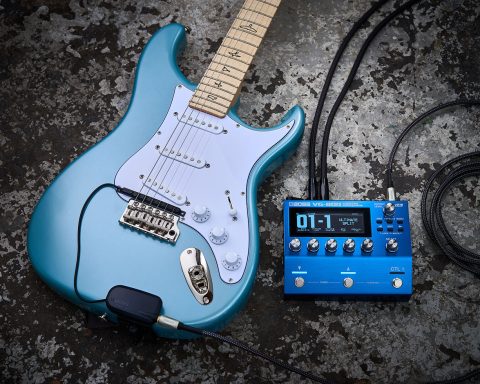First introduced in the ’70s, the fabled guitar synthesizer has had quite the journey. From early synth modules built into guitars and the inception of MIDI to today’s powerful ZEN-Core technology and serial GK system, the guitar synthesizer has evolved thanks to tireless innovation and tech advancements by BOSS and parent company Roland. Immerse yourself in guitar synthesizers and open your world to this powerful sound creation tool.
What is a Synthesizer?
Before getting into guitar synths, what do we mean by synthesizer? A synthesizer, or synth for short, is an instrument capable of creating a wide range of electronically generated sounds. The first synthesizers used analog circuitry and generated simple waveforms like sine, triangle, sawtooth, and square. Users could process them via filters, pitch modulation (vibrato), and envelope shapers. The resulting sounds were not direct emulations of anything in the acoustic instrument world.
The original Roland SH-101 is an excellent example of an analog synthesizer. Players controlled these instruments using a keyboard with switches beneath the keys. These switches told the synth what pitch to play and when to start and end each note.
Synthesis Evolves
After the introduction of affordable digital technology, additional synthesis methods evolved. These ranged from wavetable and frequency modulation (FM) to sample-based synthesis and physical modeling. Sample-based synthesis uses short recordings of real instruments playing individual notes instead of the more simplistic waveform oscillators of early analog synths.
Users could still tweak final sounds using envelope shapers and filters. However, there’s no limit to the types of instruments one can capture as samples. These synths could recreate the sounds of various acoustic instruments or human voices. So, they were no longer limited to creating only abstract sounds. In addition to the pitch and note on/off capabilities of early synths, digital instruments usually responded to velocity. This allowed players to incorporate piano-like playing dynamics into a performance.
"A synthesizer, or synth for short, is an instrument capable of creating a wide range of electronically generated sounds."
Introducing MIDI
With the digital age came MIDI (Musical Instrument Digital Interface). MIDI was an electronic communication standard for music, and Roland was one of the protocol’s founders. MIDI carries information from a controlling device, such as a keyboard or computer, to one or more instruments (or other devices, such as effects) over cables designated MIDI In and MIDI Out.
It is important to note that MIDI can carry much helpful information. It can tell an instrument what notes to play, when to play them, and how loud they should be. In addition, MIDI can select different sound patches, access controls remotely, carry pitch bend and modulation information, and more. A single MIDI feed can also control up to 16 connected devices at a time, each one set to a different channel.
What is a Guitar Synthesizer?
MIDI control is tailor-made for keyboard instruments since switches produce non-ambiguous information. They are either on or off. Getting a conventional electric guitar or bass to control a synthesizer is different. The development of guitar synthesis has branched in many directions.
Some controlling instruments have nothing in common with a guitar other than note-fingering. There have been instruments with physical switches built into the fretboard. Others have frets as switches or separate strings for fingering and picking. Roland’s controllers resemble conventional electric guitars in addition to synth control.
"The 1970s GR-500 guitar synth had hexaphonic pickups housing six small individual pickups in a single unit."
Hex for Short
The technical challenges in using a guitar to control a synthesizer are significant. Unlike on a keyboard, there are no simple switches to tell the synth what note to play. As a result, it’s necessary to measure the pitch of each string and also to detect when picking. A good solution is a separate pickup for each string, a strategy used by Roland going back to the original 1970s GR-500 guitar synth. This hexaphonic (or Hex for short) pickup houses six small individual pickups in a single unit.
The output from a conventional guitar pickup is very complex as the sound from all six strings gets mixed. By using a pickup with a separate section for each string, each signal can get processed independently. A guitar string can only generate one note at a time. This makes it easier to deal with than trying to extract the pitches from six notes playing simultaneously.
The GR-500 processing was all analog. Now, digital processing algorithms can read the pitch of a guitar string more accurately and without noticeable delay. The extracted pitch, timing, and loudness get converted into MIDI data and can control any MIDI-compatible synthesizer. As a result, there is no limit to the types of sound that one can play from the guitar. A typical guitar synthesizer will have a set of sounds. But using MIDI, it can control other synthesizers.
"A typical guitar synthesizer will have a set of sounds. But using MIDI, it can control other synthesizers."
A Brief History of Roland Guitar Synthesis
Roland’s guitar synth journey started in 1977 with the GR-500, an analog guitar synth. It sported a conventional guitar pickup and a hex pickup to separate the signals from individual strings. It had pad, bass, and lead sections and could output a control voltage to drive an external mono synth. It also featured an electromagnetic system to keep the strings vibrating for infinite sustain.
Next came the GR-300. A departure, the instrument used the waveforms from the strings to trigger a sawtooth wave generator. It featured clever pitch-shifting technology based on an electronic circuit called a phase-locked loop. The GR-300 had a straightforward set of controls and produced mainly pseudo-string and pseudo-brass sounds. It responded well to standard guitar playing techniques and was easy to use. The futuristically shaped GR-700, released in 1984, was the last Roland guitar synth requiring a dedicated guitar.
The GR range of guitar synths continued as hardware units compatible with a divided pickup system that players could mount on nearly any guitar. 2011’s GR-55 is still current. One of the reasons the GR-55 has remained so popular is that it combines a GR-style, sample-based guitar synthesizer with VG-derived guitar, amp, and FX modeling in a single unit that is easy to operate.
"After the first three Roland GR guitar synths, the next step was a divided pickup and control box to virtually any guitar."
What is a Hex/GK Pickup?
After the first three Roland GR guitar synths, the next step was a divided pickup and control box for virtually any guitar as long as there was space to fit it close to the bridge. This was the GK pickup and included both six-string and bass versions. Though the GK range has undergone several revisions, it remains a current product. The technology comprises a pickup and a small control box that players can fix to the guitar’s strap button or the guitar body.
This outputs its signals on a 13-pin DIN cable. It is compatible with all the Roland GR models from the GR-1 onwards and those BOSS SY-series guitar synthesizers requiring a GK pickup. The same GK pickups are compatible with the Roland VG range of processors discussed in the next section.
Different Types of Guitar Synthesizers
There are two main types of guitar synthesizers from Roland and BOSS. The most elaborate are those GR and GM models that support MIDI and host a range of on-board sample-based sounds. The other type, which are members of the SY series (or condensed into a compact pedal format), remodel the waveform coming from the guitar strings themselves, which provides the guitarist with something more akin to a traditional stomp-box effect experience. The SY sounds follow the dynamics of the guitar performance and lean towards more abstract, analog synth-style sounds.
"The SY sounds follow the dynamics of the guitar performance and lean towards more abstract, analog synth-style sounds."
VG Series Processors
COSM, or Composite Object Sound Modeling, was a new type of guitar synthesis. This was first used in the VG-8 guitar processor launched in 1995, superseded by the VG-88 in 2000. Notably, the VG-series processors were not primarily synthesizers but a means of modeling different guitar pickups, amplifiers, and effects. However, they included a few COSM synth-like sounds. The latest processor in the VG series was 2010’s VG-99.
Rather than extracting the pitch of each string and using this to generate control data, COSM uses the vibration of the string itself. It splits the vibration into harmonic components and then processes these separately. Again, this requires a guitar with a GK-compatible divided pickup. COSM allows for analog-style synth sounds that respond naturally to traditional playing technique. By accessing the individual string signals, the VG processors could also use pitch shifting on individual strings to create 12-string sounds and various open tunings without retuning the guitar.

The BOSS SY Range
The SY-200, SY-300, and SY-1 all work with a conventional guitar. By contrast, the SY-1000 requires a guitar fitted with a GK pickup system to exploit its capabilities thoroughly. With a regular guitar input, it will share sounds with the GR-300.
Launched in 2015, the BOSS SY-300 was the first guitar synth that did not require a divided pickup. Advanced digital processing reconstructs the harmonic output from the strings. Processing via filters, pitch shifters, and envelope shapers create a wide range of analog-synth sounds. The BOSS SY-300 offers this with a stompbox-playing experience. It requires no change in playing technique, so it may appeal to guitarists who typically shy away from more complex guitar synths. Smaller pedals like the SY-200 and SY-1 utilize the same technology as the SY-300. These units are ideal for guitar players who need a few easy-to-access synth sounds and don’t want to fit a GK pickup.
The SY-1000 adds a host of advanced features, including dynamic analog-style sounds, guitar modeling, alternate tuning, a high-quality preamp, and effects derived from the flagship GT-1000.
The later SY-1000 model included the SY-300 technology. However, it also contains further synth sections requiring a GK pickup. The SY-300 and SY-1000 produce synth sounds that straddle the guitar and keyboard worlds. Organic sounding, the output from an SY guitar synth responds to changes in playing technique. It usually has more timbral complexity than a basic analog keyboard synth. The pedal follows note bends and vibrato naturally. Overall, these synths are more forgiving of less clean playing techniques than those that trigger MIDI sounds. They can suggest the sound of strings, synth pads, analog leads, synth basses, brass, or organs.
"The GM-800 boasts an extraordinary range of natural and abstract sounds based on a library of samples."
The BOSS GM-800
The GM-800 uses a new serial connection protocol for the divided pickup using a TRS jack rather than a 13-pin DIN connection. Still, adaptors are available that allow existing GK pickups to drive a GM-series synth.
First of the new GM-series synths, the GM-800 boasts an extraordinary range of natural and abstract sounds based on a library of samples and integrates with Roland Cloud. On the sound generation front, it offers much the same variety as a sample-based MIDI keyboard synth. It also emulates analog synths effectively. Behind the scenes, new pitch-tracking algorithms ensure accurate note detection with negligible latency. The GM-800 also joins the ranks of ZEN-Core-compatible instruments.
BOSS continues to innovate in the world of guitar synthesis systems. With the EURUS GS-1, BOSS brought its advanced synth engine into a high-quality electric guitar. The instrument allows guitarists to access a range of synth sounds as easily as using an overdrive. The EURUS GS-1 builds on BOSS technology while breathing fresh air into the guitar synth conversation.
Using a Guitar Synthesizer
Beloved by everyone from Andy Summers and Robert Fripp to Matt Bellamy of Muse and Tame Impala’s Kevin Parker, guitar synths can flesh out a band’s sound with textured pads or create cutting lead tones. As with traditional tabletop synthesizers, guitar synths can open up a universe of tones with a few clicks. For guitarists who are the primary instrument in their lineup, this range of options can shape the vibe of the material. By contrast, solo players can use guitar synths to create entire sonic landscapes.
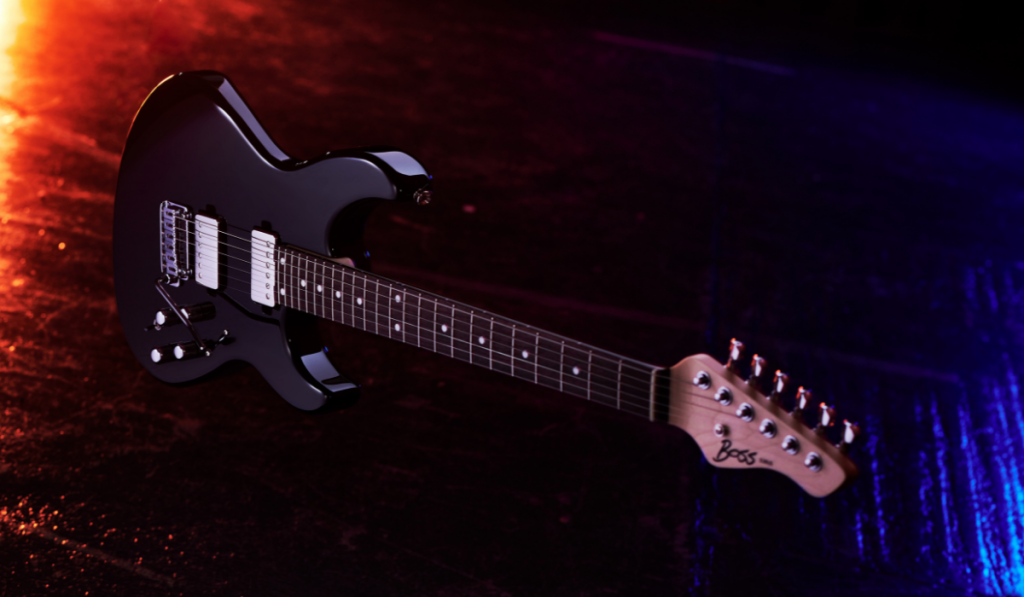
Choosing a Guitar Synth
How does one choose which guitar synth to use? If you need a simple and compact means of producing synth-style pads, leads, or basses, then the SY-1 pedal is the most straightforward. It offers a range of 121 practical synth sounds are tweakable using a few controls. For best results, it should come at the start of the effects chain.
"For players who need to emulate specific instrument sounds, a sample-based unit like the GM-800 is ideal."
The SY-200 and SY-300 provide tonal flexibility with a similarly natural playing experience. The next step up for more sophisticated analog-style sounds is the SY-1000. For players who need to emulate specific instrument sounds, a sample-based unit like the GM-800 is ideal. Whatever path you take, the guitar synth offers endless opportunities for sonic experimentation.

